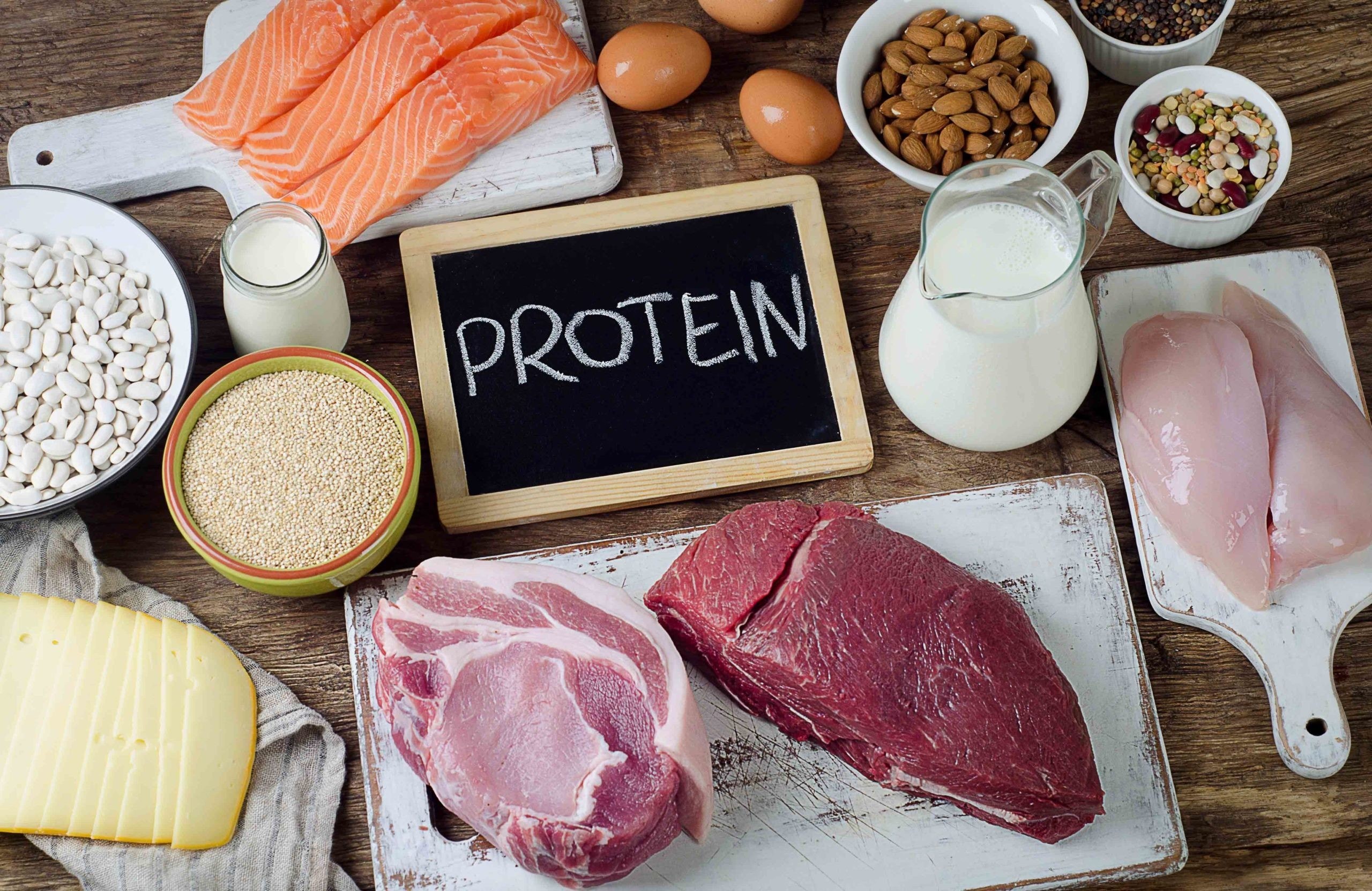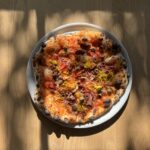Protein is an essential nutrient vital for numerous bodily functions. It plays a crucial role in building and repairing tissues, supporting immune function, and producing enzymes and hormones. Ensuring you consume enough protein daily is key to maintaining good health. But What Foods Have Protein? Fortunately, protein is widely available in a diverse range of foods, both from animal and plant sources, making it easy to incorporate into your diet.
Understanding Protein and Amino Acids
Proteins are complex molecules composed of smaller units called amino acids. Think of amino acids as the building blocks of protein. There are approximately 20 different amino acids, which combine in various sequences to form the proteins our bodies need. These proteins are essential for building new tissues like muscles and bones, and also for creating vital compounds such as enzymes and hormones. Your body can even use amino acids as a source of energy when needed.
Of these 20 amino acids, 11 can be synthesized by your body itself. These are known as non-essential amino acids. However, the remaining 9, termed essential amino acids, cannot be produced internally and must be obtained through your diet. Therefore, consuming a variety of protein-rich foods is crucial to ensure your body receives all the essential amino acids it needs to function optimally.
The Nutritional Value of Protein Sources
The nutritional quality of a protein source is determined by its amino acid profile, specifically the amount of essential amino acids it contains. Foods are categorized based on whether they provide all essential amino acids in adequate amounts.
Generally, animal-based products are considered high-quality or complete proteins because they naturally contain sufficient amounts of all essential amino acids. Examples include:
- Meat: Beef, pork, lamb, and game meats are excellent sources of protein.
- Poultry: Chicken, turkey, and duck are also rich in protein.
- Fish and Seafood: Fish, shrimp, crab, and lobster are not only protein-rich but also provide beneficial omega-3 fatty acids.
- Dairy Products: Milk, cheese, yogurt, and eggs are complete protein sources.
Certain plant-based foods also stand out as complete protein sources:
- Soy Products: Tofu, tempeh, and edamame are excellent plant-based sources of all essential amino acids.
- Quinoa: This grain is a complete protein and a versatile addition to any diet.
- Amaranth: Similar to quinoa, amaranth is another grain that provides all essential amino acids.
Other plant proteins, while not always considered complete on their own, still contribute significantly to protein intake:
- Legumes: Beans, lentils, chickpeas, and peas are good sources of protein and fiber.
- Nuts and Seeds: Almonds, walnuts, sunflower seeds, and chia seeds provide protein along with healthy fats and micronutrients.
- Whole Grains: While grains are primarily carbohydrates, whole grains like oats, brown rice, and whole wheat also contain protein.
For individuals following vegetarian or vegan diets, it’s important to consume a diverse range of plant-based protein sources to ensure they obtain all essential amino acids. Combining different plant proteins throughout the day, such as grains with legumes, can create complete protein profiles comparable to animal sources. For instance, a meal of beans and rice provides all essential amino acids, much like a meat-based dish.
 Diverse protein sources – image showcasing foods high in protein content.
Diverse protein sources – image showcasing foods high in protein content.
What Foods Are High in Protein? – Exploring Protein Food Groups
To answer the question “what foods have protein?” more specifically, let’s delve into various food groups rich in this vital nutrient:
1. Lean Meats:
- Beef, Lamb, Veal, Pork, Kangaroo: These red meats are excellent sources of protein and iron. Opt for leaner cuts to reduce saturated fat intake.
2. Poultry:
- Chicken, Turkey, Duck, Goose: Poultry is a versatile and widely consumed protein source. Skinless chicken and turkey breast are particularly lean.
3. Fish and Seafood:
- Salmon, Tuna, Cod, Trout, Shrimp, Crab, Lobster: Seafood is not only protein-rich but also packed with omega-3 fatty acids, beneficial for heart and brain health.
4. Eggs:
- Chicken Eggs: Eggs are a complete protein source and incredibly versatile for cooking.
5. Dairy Products:
- Milk, Yogurt (especially Greek Yogurt), Cheese (especially Cottage Cheese): Dairy provides protein, calcium, and other essential nutrients. Choose low-fat or non-fat options to manage fat intake.
6. Nuts and Seeds:
- Almonds, Walnuts, Cashews, Chia Seeds, Flaxseeds, Pumpkin Seeds, Sunflower Seeds: Nuts and seeds are convenient snacks and additions to meals, offering protein, healthy fats, and fiber. Nut butters (peanut butter, almond butter) are also protein-rich.
7. Legumes and Beans:
- Lentils, Chickpeas, Black Beans, Kidney Beans, Navy Beans, Tofu, Edamame: Legumes are excellent plant-based protein sources, high in fiber and versatile for soups, stews, salads, and more.
8. Grains and Cereals (Moderate Protein Sources):
- Quinoa, Oats, Brown Rice, Whole Wheat Bread: While not as protein-dense as the groups above, whole grains contribute to daily protein intake, especially when consumed regularly.
Meeting Your Daily Protein Needs Through Food
Meeting your daily protein requirements is achievable by incorporating a variety of these protein-rich foods into your diet. Dietary guidelines generally recommend consuming protein from diverse sources to ensure a balanced intake of amino acids and other nutrients.
The two primary food groups that significantly contribute to protein intake are:
- The “Lean Meat and Poultry, Fish, Eggs, Tofu, Nuts and Seeds, and Legumes/Beans” Group: This group encompasses the most concentrated sources of protein.
- The “Milk, Yogurt, Cheese and/or Alternatives (mostly reduced fat)” Group: Dairy products and fortified plant-based alternatives also contribute substantially to protein intake.
Dietary guidelines often recommend specific daily servings from each food group based on factors like age, gender, and activity level. The human body cannot store protein efficiently, so it’s best to distribute protein intake throughout the day, consuming smaller portions at each meal rather than a large amount at once.
Recommended Daily Servings of Protein-Rich Foods for Adults (Example based on general guidelines – consult specific dietary guidelines for your region):
| Person | Servings of Lean Meat, Poultry, Fish, Eggs, Nuts, Seeds, Legumes/Beans | Servings of Milk, Yogurt, Cheese, or Alternatives |
|---|---|---|
| Adult Men | 2-3 Servings | 2-3 Servings |
| Adult Women | 2 Servings | 2-3 Servings |
| Older Adults (65+ years) | 2-3 Servings (may need slightly more) | 3-4 Servings (may need slightly more) |
| Pregnant & Lactating Women | 3 Servings (or as advised by healthcare provider) | 2-3 Servings |
What constitutes a “serving”? (Example serving sizes – refer to your local dietary guidelines for precise measurements):
“Lean Meat, Poultry, Fish, Eggs, Nuts, Seeds, Legumes/Beans” Serving Examples:
- 3-4 ounces (85-113 grams) cooked lean meat, poultry, or fish
- 2 large eggs
- 1 cup (about 240ml) cooked beans, lentils, or chickpeas
- 1/4 cup (about 30 grams) nuts or seeds
- 2 tablespoons nut butter
“Milk, Yogurt, Cheese, or Alternatives” Serving Examples:
- 1 cup (about 240ml) milk or fortified plant-based milk alternative
- 1 cup (about 240ml) yogurt
- 1.5 ounces (about 42 grams) hard cheese
Protein needs vary for children and teenagers as they grow. Consult specific dietary guidelines for recommended servings for these age groups.
Tips to Increase Protein Intake Naturally
If you’re looking to boost your protein intake, here are practical and natural ways to incorporate more protein into your daily meals:
- Start with a Protein-Rich Breakfast: Include eggs, Greek yogurt, or oatmeal with nuts and seeds.
- Snack Smart with Protein: Choose snacks like nuts, seeds, hard-boiled eggs, cheese sticks, or hummus with vegetable sticks instead of processed snacks.
- Add Legumes to Meals: Incorporate beans, lentils, or chickpeas into soups, salads, stews, and pasta dishes.
- Top Salads with Protein: Add grilled chicken, fish, tofu, beans, or hard-boiled eggs to salads.
- Use Greek Yogurt Versatilely: Use Greek yogurt as a base for dips, sauces, or as a topping for fruits and cereals.
- Include Nuts and Seeds in Recipes: Sprinkle nuts and seeds on salads, yogurt, oatmeal, stir-fries, and baked goods.
- Choose Protein-Rich Grains: Opt for quinoa or whole wheat pasta over refined grains.
- Nut Butter Power: Enjoy natural nut butter on toast, apples, or celery sticks.
Protein Deficiency: What Happens When You Don’t Get Enough?
Protein deficiency, or not getting enough protein in your diet, is relatively uncommon in developed countries where food is abundant. However, it can occur, particularly in individuals with specific dietary restrictions, older adults, or those with certain health conditions.
Symptoms of protein deficiency can include:
- Muscle Weakness and Loss (Muscle Atrophy): Protein is essential for muscle maintenance and growth.
- Fatigue and Low Energy: Protein plays a role in energy production.
- Edema (Swelling): Fluid retention, especially in the ankles and feet, can occur due to protein deficiency.
- Hair Loss and Brittle Nails: Protein is a component of hair and nails.
- Weakened Immune System: Protein is needed for immune cell function.
- Slow Wound Healing: Protein is crucial for tissue repair.
- Growth Problems in Children: Protein is vital for growth and development.
Protein for Maintaining Muscle Mass as You Age
As we age, starting around age 50, we naturally begin to lose muscle mass, a condition known as sarcopenia. This muscle loss can be accelerated by factors like chronic illness, poor diet, and inactivity.
Adequate protein intake is crucial for older adults to help maintain muscle mass and strength. Preserving muscle mass is important for maintaining mobility, balance, and reducing the risk of falls and injuries.
For older adults, “eating protein effectively” means not only meeting daily protein recommendations but also choosing high-quality protein sources like lean meats, poultry, fish, eggs, and dairy, and distributing protein intake throughout the day.
Protein Shakes, Powders, and Supplements: Are They Necessary?
For most individuals with a balanced diet, protein shakes, powders, and supplements are generally not necessary. Studies show that the vast majority of people get sufficient protein from their regular food intake.
Excess protein beyond what the body needs is either excreted or stored as fat. The most effective way to meet your protein needs is to focus on consuming a variety of whole, protein-rich foods as part of a balanced dietary pattern.
Protein supplements may be considered in specific situations, such as for athletes with very high training demands or individuals with certain medical conditions that increase protein needs or make it difficult to eat enough whole foods. However, it’s always best to consult with a healthcare professional or registered dietitian before using protein supplements to determine if they are necessary and appropriate for your individual needs.
Protein and Exercise: Fueling Your Body for Activity
Consuming protein after exercise is beneficial for muscle recovery and repair. It’s often recommended to have a source of high-quality protein along with carbohydrates shortly after exercise to support muscle protein synthesis. This is beneficial even after moderate exercise, such as walking, especially for older adults.
However, for individuals engaging in vigorous exercise or trying to build muscle mass, simply increasing protein intake alone is not enough to significantly increase muscle growth. Muscle growth is primarily stimulated by resistance exercise (weight training) that challenges muscle tissue. While adequate protein is essential to support muscle repair and growth in response to exercise, excessive protein intake beyond what the body can utilize for these processes does not lead to greater muscle gains.
Very High Protein Diets: Potential Risks
Some fad diets promote extremely high protein intakes, often exceeding recommended levels by several times. While protein is essential, consuming excessively high amounts of protein can pose potential health risks.
Very high protein diets may:
- Strain the Kidneys: The kidneys are responsible for filtering waste products from protein metabolism. Excessive protein intake can put extra burden on kidney function.
- Strain the Liver: The liver is also involved in protein metabolism, and very high protein diets may place additional stress on liver function.
- Increase Calcium Loss: Some studies suggest that very high protein diets might lead to increased calcium excretion, potentially increasing the risk of osteoporosis over time.
- May Lack Fiber and Other Nutrients: Diets heavily focused on protein may sometimes lack sufficient fiber, vitamins, and minerals if not carefully planned.
It’s important to obtain protein from a balanced diet that includes a variety of nutrient-rich foods and to adhere to recommended protein intake guidelines for optimal health and to avoid potential risks associated with excessive protein consumption.
In conclusion, “what foods have protein?” is a question with a wide array of answers. Protein is abundant in both animal and plant-based foods. By incorporating a variety of lean meats, poultry, fish, dairy, eggs, legumes, nuts, seeds, and whole grains into your diet, you can easily meet your daily protein needs and support overall health and well-being. Remember to prioritize whole food sources of protein and consult with a healthcare professional or dietitian for personalized dietary advice, especially if you have specific health concerns or dietary requirements.

